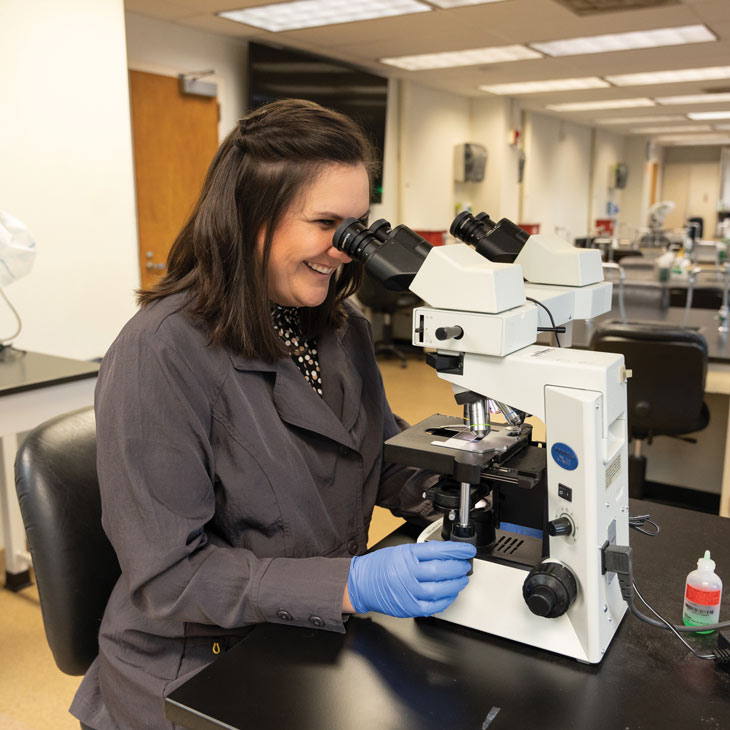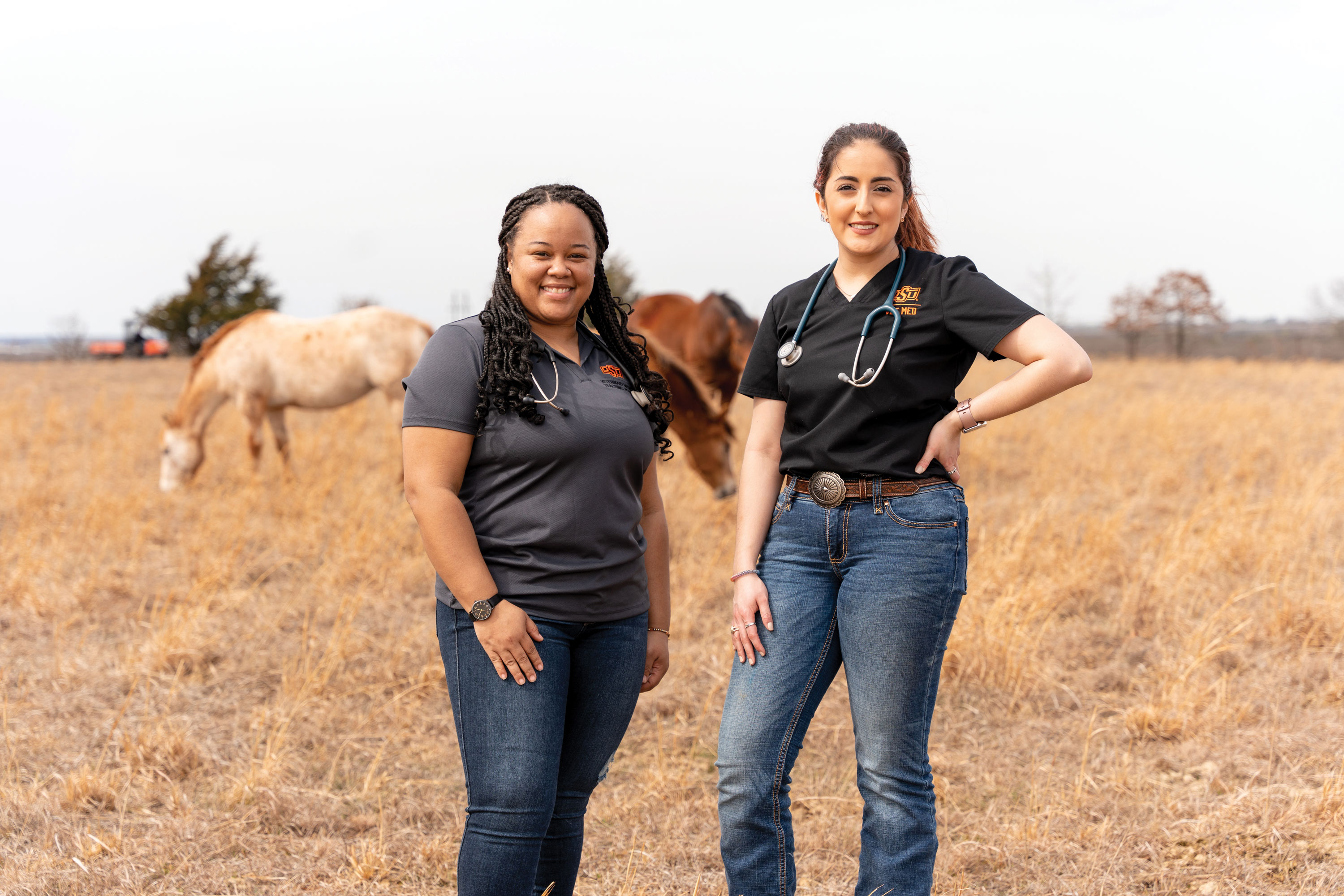
Making Their Mark: Female veterinarians have earned their place over OSU's 75-year history of CVM
Thursday, January 18, 2024
Media Contact: Taylor Bacon | Public Relations and Marketing Coordinator | 405-744-6728 | taylor.bacon@okstate.edu
There was a common sight as the first class of veterinarians graduated from the Oklahoma Agricultural and Mechanical College School of Veterinary Medicine in 1951.
There were 26 members. All were men.
The first woman to earn her DVM from OAMC wouldn’t come until four years later: Dr. June Iben in 1955.
Gradually, as society changed, more women pursued their degree and entered the veterinary profession. In the class of 1990, female students outnumbered male students for the first time in the college’s four-decade history with 34 women and 31 men.
Today, women represent the larger percentage of veterinary students in the now Oklahoma State University College of Veterinary Medicine. In the most recent class, 95 students are women compared to 14 male students. As more and more women pursue careers in veterinary medicine, Vet Cetera magazine looks back on the steps it took to get here.
Changing Stigmas
Dr. Becky Brewer, class of 1984, was one of 22 women in her class of 64 students. While the representation in the CVM had gotten better, there were still people in the industry who hadn’t changed with the times.
During her time at OSU, there was a hospital client who didn’t allow women on his cattle ranch. Brewer looked to change that.
“I was doing my handoff to the staff before I headed home and he called,” Brewer said. “I begged them, ‘Let me go and let me take female students.’ We went out there and he didn’t kick us off the property.
“I don’t know if he ever let women come again, but it was a great experience.”
Throughout her career, Brewer never let being a female veterinarian stop her from accomplishing what she wanted. She went on to be the first female state veterinarian for Oklahoma and paved the way for female veterinarians after her.
One of those women is Dr. Rosslyn Biggs, the second woman in her family to earn an OSU DVM. Biggs grew up in Chickasha, Oklahoma, where Brewer owned a mixed animal practice.
With inspiration from women like her mother, Dr. Margaret “Peggy” Clark, and Brewer, Biggs decided early in her childhood she wanted to be a veterinarian.
“Being a woman in veterinary medicine is exciting. Historically, veterinary medicine has been a majority white male profession, so it is exciting to be an African American female pursuing this career.”
“I find the veterinary profession inspiring and the DVM degree gives such a versatile path,” said Biggs, director of continuing education and assistant clinical professor. “You can truly make it what you want it to be. I am proud to hopefully improve the lives of people and their animals each day in some small way.”
While women entering the veterinary medical field has become more common, they are still the minority in some practice areas.
“In food animal medicine, we are still a minority but rapidly growing,” said Dr. Meredyth Jones, professor of food animal medicine. “I have always been proud to be a food animal veterinarian and through a solid educational background and the mentorship of many amazing women, I have found food animal medicine to be a great fit for me as a woman.”
Jones was asked by several students if she’s had challenges working with food animal clients. Her approach is to bring her best to every client.
“I show them I care about what they need and then show them what I am capable of doing to serve them,” Jones said. “Even if they were a bit uneasy initially working with a woman, they can’t really argue with results.”
Inspiring Students

Even though women are more commonly entering fields that involve science, technology, engineering and math, there are still many roadblocks women in STEM face. This was true for Dr. Jennifer Rudd, assistant professor of veterinary pathobiology.
She recalled a time she was struggling in her middle school math class. Rudd’s teacher told her parents she just wasn’t cut out for it and wasn’t good at math. Rudd said most young girls think they are “bad at math” before they turn 9. By age 12, girls are already less interested in STEM.
Even Rudd wasn’t sure she wanted to be a veterinarian until relatively late in college.
“I knew I liked math and science but was considering engineering or human medicine,” she said. “Ultimately, it was my family support and my love for One Health that encouraged me to become a veterinarian.”
For Rudd, veterinary medicine is the perfect blend of her passions — animals, science and human connection. While her journey hasn’t come without its own unique challenges, she is proud of where she is today.
“I am so proud to be a woman in science, research, academia and veterinary medicine. Not only that, but a woman in STEM with a career and three amazing young kids,” she said. “It’s not always pretty, but I hope I can be an example for my students of how women can do anything they set their minds to and find joy in their purpose.”
Faculty members like Biggs, Jones and Rudd are inspiring the next generation of female veterinarians within the CVM.
Brie Shillingford is a fourth-year student from Tulsa. Growing up, her family always allowed her to follow her dreams and encouraged her to pursue her passions. From an early age, she knew her love for animals would play a major role in her life but wasn’t sure what that may look like.
“Just about every woman I know can share a story of a time they felt less than because of their gender. While we are resilient, we have to change this for our daughters.”
She began working at a veterinary clinic after college and discovered her passion for veterinary medicine. After five years of working at the clinic and a few years after the birth of her son, Shillingford set her mind and heart to follow her dream of becoming a veterinarian, a dream she always thought was just out of reach.
“Being a woman in veterinary medicine is exciting,” Shillingford said. “Historically, veterinary medicine has been a majority white male profession, so it is exciting to be an African American female pursuing this career.”
As Shillingford gets closer to achieving this dream, she said it is important to her to set an example for her son and others who look like her.
“I am proud to be following my dreams, despite the hardships and proud to be an example of compassion, perseverance, diversity and intelligence,” she said.
Becky Garcia, a fourth-year student from El Paso, Texas, said she is honored to stand alongside like-minded people who have dedicated their lives to the health and well-being of their patients.

“I am proud to be a woman inveterinary medicine because I havebeen given the opportunity to make a difference in my community,” Garcia said. “We as veterinarians are the voice of our patients. From aiding in the prevention of outbreaks in a herd to being the reason a little girl gets to take her best friend home happy and healthy, I’m proud to know I can make a difference.”
Paving the Way
Although veterinary medicine has made leaps and bounds since Brewer’s difficult cattle client who wouldn’t allow women on his ranch, there are still challenges ahead.
“Just about every woman I know can share a story of a time they felt less than because of their gender,” Rudd said. “While we are resilient, we have to change this for our daughters.”
Rudd said this degree opens the door for countless opportunities and advised young women to follow their dreams.
“Pursue your passions and don’t waste them,” Rudd said. “If there’s no precedent for what that looks like, then be the first.”
Likewise, Jones has never let anyone discourage her from pursuing her passions and advises the same for young women in the field.
“Don’t go into this profession focused on the way people may judge you whether it’s for being a woman, being young or any other way you may feel you’ll be judged,” Jones said. “Train hard, focus on what people need, shake their hand and do good work. Everything will work itself out from there.”
Photo By: Taylor Bacon
Story By: Taylor Bacon | Vet Cetera Magazine
